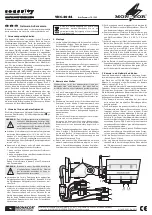
2) Network
The network camera support both IP version 4 and IP version 6. Both versions may be enabled
multaneously, and at least one version must always be enabled. When using IPv4, the IP address for
e
y.
I
et
fo
Obtain IP address via DHCP
ol
er is mostly
mera,
check the radio button and then make the following settings:
dress:
ication, or if your DHCP server can
work Camera by name (host name).
d and you cannot access the unit, you may have to reset it to the factory
default settings and then perform the installation again.
. The ARP/Ping service is automatically disabled two minutes after the unit is started, or
as soon as an IP address is set.
. Pinging the unit is still possible when this service is disabled.
si
th video encoder can be set automatically via DHCP, or a static IP address can be set manuall
Pv6 is enabled, the video encoders receive an IP address according to the configuration in the
work router. There is also the option of using the Internet Dynamic DNS Service. For more
rmation on setting the Network, please see Setup> System>Security>Network.
If
n
in
•
- Dynamic Host Configuration Protocol (DHCP) is a protoc
that lets network administrators centrally manage and automate the assignment of IP
addresses on a network. DHCP is enabled by default. Although a DHCP serv
used to set an IP address dynamically, it is also possible to use it to set a static, known IP
address for a particular MAC address.
•
Use the following IP address
- To use a static IP address for the Network Ca
-
IP ad
Specify a unique IP address for your Network Camera.
-
Subnet mask:
Specify the mask for the subnet the Network Camera is located on.
-
Default router:
Specify the IP address of the default router (gateway) used for
connecting devices attached to different networks and network segments.
Notes:
1. DHCP should only be enabled if using dynamic IP address notif
update a DNS server, which then allows you to access the Net
If DHCP is enable
2
3
22
















































